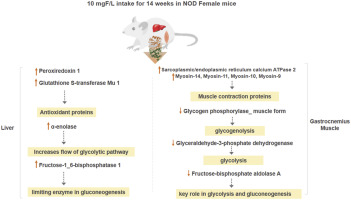当前位置:
X-MOL 学术
›
Chemosphere
›
论文详情
Our official English website, www.x-mol.net, welcomes your feedback! (Note: you will need to create a separate account there.)
Effects of low-level fluoride exposure on glucose homeostasis in female NOD mice.
Chemosphere ( IF 8.8 ) Pub Date : 2020-04-06 , DOI: 10.1016/j.chemosphere.2020.126602 Juliana Sanches Trevizol 1 , Nathalia Rabelo Buzalaf 1 , Aline Dionizio 1 , Aislan Quintiliano Delgado 2 , Tania Mary Cestari 1 , José Roberto Bosqueiro 3 , Ana Carolina Magalhães 1 , Marilia Afonso Rabelo Buzalaf 1
Chemosphere ( IF 8.8 ) Pub Date : 2020-04-06 , DOI: 10.1016/j.chemosphere.2020.126602 Juliana Sanches Trevizol 1 , Nathalia Rabelo Buzalaf 1 , Aline Dionizio 1 , Aislan Quintiliano Delgado 2 , Tania Mary Cestari 1 , José Roberto Bosqueiro 3 , Ana Carolina Magalhães 1 , Marilia Afonso Rabelo Buzalaf 1
Affiliation

|
Water fluoridation is an important public health measure for the control of dental caries. Recent animal studies have shown that low doses of fluoride (F) in the drinking water, similar to those found in public water supplies, increase insulin sensitivity and reduce blood glucose. In the present study we evaluated the effects of low-level F exposure through the drinking water on glucose homeostasis in female NOD mice. Seventy-two 6-week mice were randomly divided into 2 groups according to the concentration of F in the drinking water (0-control, or 10 mg/L) they received for 14 weeks. After the experimental period the blood was collected for analyses of plasma F, glucose and insulin. Liver and gastrocnemius muscle were collected for proteomic analysis. Plasma F concentrations were significantly higher in the F-treated than in the control group. Despite treatment with fluoridated water reduced plasma levels glucose by 20% compared to control, no significant differences were found between the groups for plasma glucose and insulin. In the muscle, treatment with fluoridated water increased the expression of proteins related to muscle contraction, while in the liver, there was an increase in expression of antioxidant proteins and in proteins related to carboxylic acid metabolic process. Remarkably, phosphoenolpyruvate carboxykinase (PEPCK) was found exclusively in the liver of control mice. The reduction in PEPCK, a positive regulator of gluconeogenesis, thus increasing glucose uptake, might be a probable mechanism to explain the anti-diabetic effects of low doses of F, which should be evaluated in further studies.
中文翻译:

低水平氟化物暴露对雌性NOD小鼠葡萄糖稳态的影响。
水氟化是控制龋齿的重要公共卫生措施。最近的动物研究表明,饮用水中的低剂量氟化物(F)与公共供水中的氟化物相似,可增加胰岛素敏感性并降低血糖。在本研究中,我们评估了饮用水中低水平F暴露对雌性NOD小鼠体内葡萄糖稳态的影响。根据72只为期6周的小鼠在14周内根据饮用水中F的浓度(0对照或10 mg / L)随机分为2组。在实验期之后,收集血液用于血浆F,葡萄糖和胰岛素的分析。收集肝和腓肠肌进行蛋白质组学分析。经F处理的血浆F浓度显着高于对照组。尽管与对照相比,用氟化水治疗可使血浆葡萄糖水平降低了20%,但两组血浆葡萄糖和胰岛素之间没有发现显着差异。在肌肉中,用氟化水处理可增加与肌肉收缩有关的蛋白质的表达,而在肝脏中,抗氧化剂蛋白质和与羧酸代谢过程有关的蛋白质的表达会增加。值得注意的是,磷酸烯醇丙酮酸羧激酶(PEPCK)仅在对照小鼠的肝脏中发现。PEPCK(糖异生的阳性调节剂)的减少,从而增加了葡萄糖的吸收,可能是解释低剂量F抗糖尿病作用的可能机制,应在进一步研究中进行评估。
更新日期:2020-04-06
中文翻译:

低水平氟化物暴露对雌性NOD小鼠葡萄糖稳态的影响。
水氟化是控制龋齿的重要公共卫生措施。最近的动物研究表明,饮用水中的低剂量氟化物(F)与公共供水中的氟化物相似,可增加胰岛素敏感性并降低血糖。在本研究中,我们评估了饮用水中低水平F暴露对雌性NOD小鼠体内葡萄糖稳态的影响。根据72只为期6周的小鼠在14周内根据饮用水中F的浓度(0对照或10 mg / L)随机分为2组。在实验期之后,收集血液用于血浆F,葡萄糖和胰岛素的分析。收集肝和腓肠肌进行蛋白质组学分析。经F处理的血浆F浓度显着高于对照组。尽管与对照相比,用氟化水治疗可使血浆葡萄糖水平降低了20%,但两组血浆葡萄糖和胰岛素之间没有发现显着差异。在肌肉中,用氟化水处理可增加与肌肉收缩有关的蛋白质的表达,而在肝脏中,抗氧化剂蛋白质和与羧酸代谢过程有关的蛋白质的表达会增加。值得注意的是,磷酸烯醇丙酮酸羧激酶(PEPCK)仅在对照小鼠的肝脏中发现。PEPCK(糖异生的阳性调节剂)的减少,从而增加了葡萄糖的吸收,可能是解释低剂量F抗糖尿病作用的可能机制,应在进一步研究中进行评估。


























 京公网安备 11010802027423号
京公网安备 11010802027423号